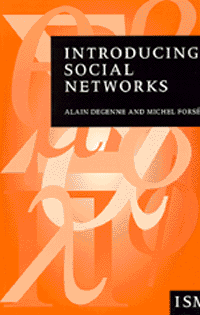

![]()
![]()

As a general introduction, the book strongly argues for core ideas. For example, social structure must mean the webs of social relationships between social actors, and we must identify social structural patterns and components from actual networks. This is apparently not news (do we not all study social structure??) But often we dodge real social structure, relying instead on mere individual attributes, as in calling a nation's age distribution its "age structure" or calling people capitalists because they own things instead of because they have certain kinds of relationships with workers, rival capitalists, and other actors. Degenne and Forse, two very serious scholars, explain how we can really study social structure through the complex mix of resources network analysis provides: a strong commitment to structural analysis, a set of highly developed tools for collecting and analyzing data (tools necessarily distinct from the more familiar methods of dealing with individual actor traits), concepts for the important components of social structure, theories about networks (including their causes, development, and consequences), and abundant interesting substantive findings. Topics include the surprisingly tough problem of estimating how many people we know, the kinds of people we know well and the kinds we know slightly, social capital, power based on central location in a network, the diffusion of information and innovation through networks, and the importance of the extent to which social circles crosscut each other and thus moderate potential conflicts. The authors disdain blandness, taking views and criticizing approaches as well as presenting a good selection of the range of options available.
As an introduction to network research done in France/French, the book can be especially helpful to anglophone scholars who are not fully aware of this rich literature. Much of this work is important as a widening of our comparative view of networks in different societies. Different social structural and cultural contexts make for differences in what networks are like and how they work, so we need high quality comparisons of the kind in this book. Other work on France is valuable precisely because there is no comparative work yet, the French work being original and thought-provoking. Much of the French research is not available in English anywhere else. At times the French focus becomes a little too narrow for a general introductory book. In an extreme example, the material on voluntary association membership (pp. 42-43) cites only French material even though comparable material is available (along with useful comparative analysis) for dozens of countries. Perhaps naturally, the leaning toward French facts is strongest for the most recent material. Work cited from the 1990s is half French and half English, while the work published in that period is much more than 50% English; some important material has been neglected. However, the book is very solid on the older network literature, especially the classics in any language, and it even includes some interesting use of relevant ideas (for example, from Hobbes) that predate network analysis as such. The translation from the original French edition of 1994 is generally clear, while still preserving the appeal of a particularly French turn to wit and imagery, often livelier and more pungent than typical English writings in the field.
As an introduction in either sense, the book is generally clear and engaging. Some aspects of it may be challenging for the truly naive reader. Sometimes the authors merely allude to issues instead of explaining them, and one would have to go the original sources cited to figure things out. The authors often use mathematical language as part of their expositions, while giving very terse explanations that the mathematically handicapped will probably not get. For a real introduction to the details of data analysis, this book is not (and no doubt was never meant to be) a rival to Stanley Wasserman and Katherine Faust's Social Network Analysis, the standard text and reference. However, the book does give enough material for a reader who has some level of comfort with basic mathematics or a student who has a more sophisticated teacher to fill in a few blanks.
Overall, this book is a valuable addition. The social network area is so lively, important, and distinctive that it needs a good new introductory book every few years. This book is more comprehensive than Wasserman and Faust (which is wonderful for statistics, but light on other important matters like substantive results), more recent and somewhat more wide-ranging than John Scott's Social Network Analysis: A Handbook, and more systematic than the various volumes of selected network readings. It packs a surprising amount of important material into a modest amount of space, and delivers the material with style.
Bonnie H. Erickson
University of Toronto
